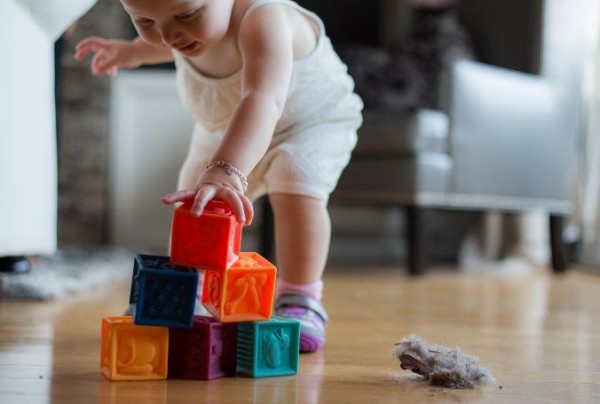Household Dust is Toxic, says New Study; Phthalates is the Top Toxin
| Arthur Dominic Villasanta | | Oct 02, 2016 11:33 PM EDT |
(Photo : Milken Institute School of Public Health at the George Washington University) Household dust exposes people to a wide range of potentially toxic chemicals, according to large first of a kind study.
A first-of-a-kind meta-analysis has discovered that common household dust exposes people, especially children, to a wide range of toxic chemicals from everyday products.
The comprehensive analysis discovered that DEHP, a chemical belonging to a hazardous class called phthalates, was number one on toxic chemical Top 10 list. In addition, researchers found that phthalates overall were found at the highest levels in dust followed by phenols and flame retardant chemicals.
Like Us on Facebook
Phthalates is a class of industrial chemicals used to soften PVC plastic and as solvents in cosmetics and other consumer products. They can damage the liver, kidneys, lungs, and reproductive system -- particularly the developing testes -- according to animal studies.
In a previous study, researchers linked phthalates to asthma, attention-deficit hyperactivity disorder, breast cancer, obesity and type II diabetes, low IQ, neurodevelopmental issues, behavioral issues, autism spectrum disorders, altered reproductive development and male fertility issues.
Several phthalates have been shown to have negative health impacts: butyl benzyl phthalate (BBzP), dibutyl phthalate (DnBP), di-2-ethylhexyl phthalate (DEHP), diethyl phthalate (DEP), di-butyl phthalate (DBP), benzyl butyl phthalate (BBP), diisobutyl phthalate (DiBP), diisononyl phthalate (DiNP), di-n-octyl phthalate (DnOP), dipentyl phthalate (DPP), di-isobutyl phthalate (DiBP), di-isononyl phthalate (DiNP), di-n-octyl phthalate (DnOP), di-isohexyl phthalate, dicyclohexyl phthalate (DcHP) and di-isoheptyl phthalate.
The new study was led by researchers at Milken Institute School of Public Health (Milken Institute SPH) at the George Washington University. The multi-institutional team conducted the meta-analysis, compiling data from dust samples collected throughout the United States to identify the top ten toxic chemicals commonly found in dust.
"Our study is the first comprehensive analysis of consumer product chemicals found in household dust," said lead author Ami Zota, ScD, MS, assistant professor of environmental and occupational health at Milken Institute SPH.
"The findings suggest that people, and especially children, are exposed on a daily basis to multiple chemicals in dust that are linked to serious health problems."
Chemicals from consumer products are released into the air and get into dust, which can settle on household items or on the floor. People can inhale or ingest small particles of dust or even absorb them through the skin.
Infants and young children are particularly at risk for exposure to the chemicals found in dust because they crawl, play on dusty floors, and put their hands in their mouths.
Zota and colleagues combined data from 26 peer-reviewed papers and one unpublished dataset that analyzed dust samples taken from homes in 14 states. They found 45 potentially toxic chemicals used in many consumer and household products such as vinyl flooring, personal care and cleaning products, building materials and home furnishings.
The team found that 10 harmful chemicals are found in ninety percent of the dust samples across multiple studies, including a known cancer-causing agent called TDCIPP. This flame retardant is frequently found in furniture, baby products and other household items.
Indoor dust consistently contains four classes of harmful chemicals in high amounts. Phthalates, substances that are used to make cosmetics, toys, vinyl flooring, and other products, were found in the highest concentration with a mean of 7,682 nanograms per gram of dust-an amount that was several orders of magnitude above the others.
Phenols, chemicals used in cleaning products and other household items, were the number two highest chemical class followed by flame retardants and highly fluorinated chemicals used to make non-stick cookware.
Chemicals from dust are likely to get into young children's bodies. A flame retardant added to couches, baby products, electronics and other products, TCEP, had the highest estimated intake followed by four phthalates--DEP, DEHP, BBzP and DnBP. The intake numbers in this study probably underestimate the true exposure to such chemicals, which are also found in products on the drug store shelf and even in fast food the authors say.
Phthalates such as DEP, DEHP, DNBP, and DIBP, are not only found at the highest concentrations in dust but are associated with many serious health hazards. Phthalates are thought to interfere with hormones in the body and are linked to a wide range of health issues including declines in IQ and respiratory problems in children.
Highly fluorinated chemicals such as PFOA and PFOS are also high on the potential harm scale. These types of chemicals, which are found in cell phones, pizza boxes, and many non-stick, waterproof and stain-resistant products have been linked to numerous health problems of the immune, digestive, developmental and endocrine systems.
Small amounts can add up. Many of the chemicals in dust are linked to the same health hazards, such as cancer or developmental and reproductive toxicity, and may be acting together. Exposure to even small amounts of chemicals in combination can lead to an amplified health risk, especially for developing infants or young children, the authors say.
"The number and levels of toxic and untested chemicals that are likely in every one of our living rooms was shocking to me," said co-author Veena Singla, PhD, staff scientist at the Natural Resources Defense Council.
"Harmful chemicals used in everyday products and building materials result in widespread contamination of our homes--these dangerous chemicals should be replaced with safer alternatives," Singla adds.
Consumers that want to reduce their exposure to chemicals in household dust and the environment around them can take a few simple steps such as keeping dust levels low by using a strong vacuum with a HEPA filter; washing hands frequently; and avoiding personal care and household products that contain potentially dangerous chemicals.
"Consumers have the power to make healthier choices and protect themselves from harmful chemicals in everyday products," says Robin Dodson, an environmental exposure scientist at Silent Spring Institute. "These things can make a real difference not only in their health but also in shifting the market toward safer products."
Tagsphthalates, household chemicals, Toxic, DEHP, Milken Institute School of Public Health, Ami Zota
©2015 Chinatopix All rights reserved. Do not reproduce without permission
EDITOR'S PICKS
-

Did the Trump administration just announce plans for a trade war with ‘hostile’ China and Russia?
-

US Senate passes Taiwan travel bill slammed by China
-

As Yan Sihong’s family grieves, here are other Chinese students who went missing abroad. Some have never been found
-

Beijing blasts Western critics who ‘smear China’ with the term sharp power
-

China Envoy Seeks to Defuse Tensions With U.S. as a Trade War Brews
-

Singapore's Deputy PM Provides Bitcoin Vote of Confidence Amid China's Blanket Bans
-

China warns investors over risks in overseas virtual currency trading
-

Chinese government most trustworthy: survey
-

Kashima Antlers On Course For Back-To-Back Titles
MOST POPULAR
LATEST NEWS
Zhou Yongkang: China's Former Security Chief Sentenced to Life in Prison

China's former Chief of the Ministry of Public Security, Zhou Yongkang, has been given a life sentence after he was found guilty of abusing his office, bribery and deliberately ... Full Article
TRENDING STORY

China Pork Prices Expected to Stabilize As The Supplies Recover

Elephone P9000 Smartphone is now on Sale on Amazon India

There's a Big Chance Cliffhangers Won't Still Be Resolved When Grey's Anatomy Season 13 Returns

Supreme Court Ruled on Samsung vs Apple Dispute for Patent Infringement

Microsoft Surface Pro 5 Rumors and Release Date: What is the Latest?














